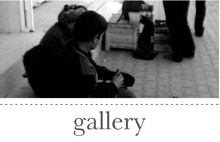Mohammed Abd al-Amir (Mohammed Chaloob) graduated with a degree in theater from the University of Baghdad’s School of Fine Arts. He is a director, actor, filmmaker, and founder of the group Nenurta for the Arts. He is developing a theater of intervention, often staged in public places in order to reach more Iraqis, despite the insecurity of the country. He has also participated in short fiction films with Nenurta’s short-film group.
Some might think that this article is a cry of distress to save the Iraqi cinema or to advance it, but we simply want to invite those interested in the subject to study its condition because its effervescence has diminished considerably, and its activities are paralyzed. In spite of the blossoming dream of an Iraqi cinema, the activities of filmmakers have slowed dramatically. Our national cinema has degraded, and no one has tried to save it. We say this based on the current state of Iraqi culture in comparison with the thriving cinema that prevailed in Iraqi society in the 19th and the beginning of the 20th centuries.
In 1909, the Iraqi audience watched the silent films of the era. The number of movie theaters grew remarkably quickly in every region of Iraq. Regular attendance at large theaters allowed for the development of a cinematic sensibility, as much in the minds of artists as the Iraqi public. People went to the theater to distract themselves, but also to participate in debates raised by the films’ varied subjects. One could see groups of children retelling the plots of the movies they had just seen.
Then, a new public was born, comprised of students, professors, public servants, and writers. Propelled by their passion for this art, they put the cinema at the heart of deep and sophisticated debates. Many of them came up with new ideas to develop the cinema and increase its humane and artistic perspectives. Movie theaters responded to the cultural tide and projected foreign films and promoted new forms of cinematography. As for the Iraqi press, they published evaluations and critiques of movies. In this way the print media contributed to the diffusion of a more refined cinematic culture throughout Iraqi society. This fever grew and reached an audience of young people who sidestepped some of their courses to go see their favorite films and actors. A great number of these dreamers enrolled in film schools in Iraq and abroad to learn the skills they needed to make use of their artistic talents in the spotlight.
It is important to mention that some of them chose to demonstrate their talents in the theater instead. They considered this branch of art more refined and better served to discuss deep subjects. In this way, the Iraqi theater flourished, benefiting from Iraqis’ artistic talents as much in performance, direction, photography, and music as in writing. In this way, the theater kept and protected these talents from deterioration and loss due to difficult cultural conditions. Thanks to its role, theater became a reliable source for Iraqi cinema and kept providing it with remarkable talents. Indeed, many theater artists find that cinema is a complementary vehicle for transmitting the artistic messages they initiated at the theater, and a great number of them have begun large projects. However, their initiatives, aimed at developing a national cinema, have faced numerous difficulties of a social, economic, and political nature.
Consequently, the Iraqi cinema project has slowed, and the enthusiastic efforts have dispersed, to such a point that when the artist Youssef Chahine was asked about his opinion on Iraqi cinema, he answered, “Is there an Iraqi cinema?” This response demonstrates that Chahine was focused on his vast and profound cinematic experiences, and that he was influenced by Egyptian and international cinema.
In the 1960s, the number of Iraqi films produced exceeded that of other countries, including Egypt. In addition to public sector productions following the creation of a service for cinema and theater in 1959, the private sector produced 17 films (an average of 5 per year) between 1961 and 1963. Among these films, “Naboukhad Nasr” (1962), directed by Kamel Al Azzawi, cost 40,000 dinars to make. In addition, Hikmat Labib Awanis directed four films during the same period, of which the last was titled, “The Leaves of Autumn” (1963). He later immigrated to the United States, disappointed! It is the lack of support and official goodwill that caused this disappointment and deteriorated the state of cinematic production in Iraq.
Moreover, we cannot completely ignore the responsibilities of actors and producers in our findings. Let us recall the films of the 1950s produced with few means. It is important to note that Hollywood’s cinema at this time was also modest, but the artists there were invested and thus capable of giving their cinematic art value, consequently creating a solid movie industry. We admit that other factors played a role in the cinema’s atrophying; factors outside the control of the Iraqi filmmaker or producer. Among these factors are the predominance of television and televised movies, in addition to the proliferation of computers and the accessibility of the Internet. We understand that this is an irreversible global phenomenon.
The fact that television has absorbed cinema fans caused cinema to lose its market. Thus artists are forced to develop and invent new forms of production. Cinema is an independent art, which must adapt to changes. It must face the challenge posed by television and try to integrate itself. We cannot imagine that television would exist today without cinema having first existed, even if television products have imposed their standards on the market. But television should encourage, not paralyze, cinema, despite the differences between each. We think that Iraqi television can help filmmakers to display their talents and promote and develop the Iraqi cinema.
We also believe that the Parliament or the Prime Minister should adopt a general work plan on the subject, involving the Ministry of Culture in conjunction with private enterprises. We need to work together to realize the noble goal of developing and aiding the Iraqi cinema.












